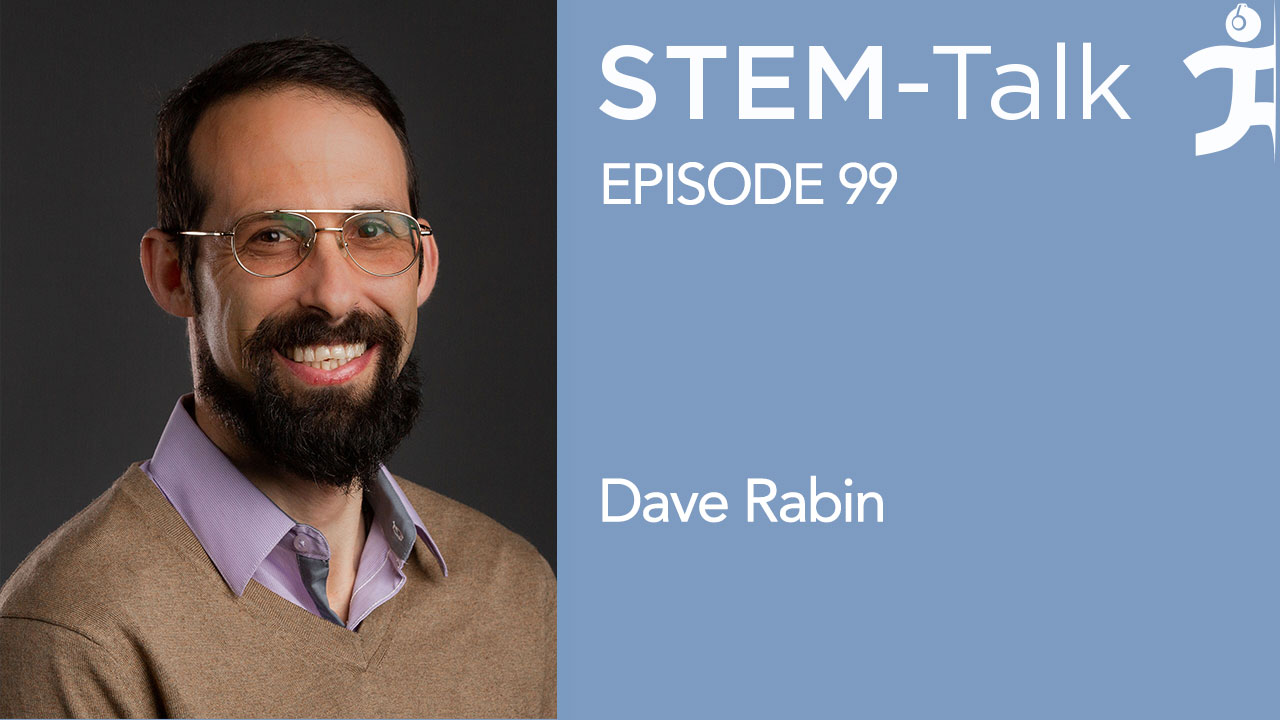STEM-Talk
Episode 99 : Dave Rabin talks about how psychedelics and wearable devices can help improve people’s lives
// Nov 26, 2019

Dr. David Rabin is the chief innovation officer and co-founder of Apollo Neuroscience. He also is the co-inventor of Apollo, a wearable device designed to improve focus, sleep and access to meditative states by gently delivering layered vibrations to the skin.
Dave is a board-certified psychiatrist and translational neuroscientist who for the past decade has been studying resilience and the impact of chronic stress on humans. He received his MD in medicine and Ph.D. in neuroscience from Albany Medical College in Albany, New York. He trained in psychiatry at Western Psychiatric Institute and Clinic at the University of Pittsburgh Medical Center.
Dave also has organized the world’s largest controlled study of psychedelic medicines and is well-known for his research into MDMA and its potential to treat posttraumatic stress disorder along with other disorders.
Show notes
[00:03:06] Dawn opens the interview mentioning that David grew up in California and asking him about an insatiable need he had as a child to understand why people were the way that they were. [00:04:18] David talks about how the vivid and frequent dreams he had as a child played a role in his decision to study consciousness and neuroscience. [00:07:33] Dawn mentions that in high school Dave told his father that he wanted to study consciousness; however, Dave’s father suggested that he study something more tangible and quantifiable instead. Dave explains how this led him to spend the summer between his junior and senior year of high school at Rockefeller University. [00:12:08] Ken asks why Dave decided to move across the country to Albany Medical College, where he received his MD in medicine and Ph.D. in Neuroscience. [00:14:01] Dave gives an overview of the research he did, while working on his Ph.D., in emotional salience and how people interpret different stimuli as either threatening or safe. An area of research informed by his reading of evolutionary psychology, and the study of touch as an evolutionarily conserved stimulator of the safety pathway. [00:17:58] Ken asks about how Dave decided to go into psychiatry at Western Psychiatric Institute and Clinic at the University of Pittsburg Medical Center, where he focused on treatment-resistant mental illnesses. [00:20:47] Dawn mentions Dave’s work with Greg Siegel. Dawn asks about this work and how it led Dave to become serious about studying consciousness, altered states of consciousness, and the potential use of these altered states to facilitate healing. [00:24:26] Ken talks about MDMA, or 3,4-Methylenedioxymethamphetamine, a psychoactive drug commonly known as ecstasy or molly. He explains that MDMA has been shown to facilitate the release of oxytocin, which increases levels of empathy and closeness while dampening fear-related amygdala activity. This results in an overall decrease in stress response and social anxiety. Ken asks Dave to talk about MDMA’s potential to treat PTSD (posttraumatic stress disorder) along with other disorders. [00:27:37] Ken asks if Dave has seen any improvements in heart rate variability (HRV) post MDMA treatments. [00:28:37] Dawn mentions that Dave is part of the world’s largest controlled study of psychedelic medicines. She goes on to explain that these medicines, like LSD and MDMA and even psilocybin, which comes from mushrooms, were used to treat mental and emotional trauma from the 1950s to the ‘70s. Due to the abuses that occurred during this time, the use as well as research on psychedelic medicines in U.S. were shut down. With a shift towards a renewed interest in these medicines, Dawn asks about this study and if Dave could give a background on psychedelic medicine. [00:32:34] Dave talks about the epigenetic trial, being conducted in phase three of the MDMA study, where DNA samples are collected before and after use, to determine the epigenetic regulation of stress-response genes. [00:41:30] Ken asks about psilocybin, which is a naturally occurring psychedelic produced by more than 200 species of mushrooms. Ken asks Dave to explain how psilocybin is different from MDMA, both chemically and experientially. [00:45:45] Dave discusses the use of ecstasy and the debate around the safety of MDMA, and how compared to stimulants such as cocaine, amphetamine and methamphetamine, addiction to MDMA is very rare. [00:48:47] Dawn explains that psychedelics are, to this day, illegal in the U.S., and further states that STEM-Talk is not advocating the use of these or any illegal substances, before asking Dave about the changing legal status of psychedelics. [00:49:51] Dawn asks about the use of cannabidiol (CBD) for management of symptoms for illnesses such as PTSD and pain-management. [00:54:17] Ken mentions that Dave has spent the last several years developing a technology called Apollo, which is intended to help people make changes more effectively. Given the research and study Dave has done into stress, meditation and athletic performance, and why some people are more resilient than others, Ken asks Dave what he has learned from all this and how it led to the Apollo technology. [00:57:31] Ken asks if the hypervigilance people have to text alerts and emails and phone vibrations and news alerts and the constant bombardment of noise and stimuli is conditioning our bodies to be in a hyper-stressed state all the time. [00:59:26] Ken asks how to retrain the nervous system to become more balanced between our sympathetic and parasympathetic symptoms without the use of psychedelics. [01:02:37] Dawn asks about cognitive patterns and the way people think about their lives, such as the tendency to take challenges personally and think “why me?” while others tend to see challenges as an opportunity for growth. [01:05:35] Dave talks about heart-rate variability (HRV) and why he considers it one of the more important findings about resilience that has been made in the past 15 years. [01:09:19] Dawn asks what a good range for HRV is, or if there is a significant degree of variation across healthy people. [01:10:31] Dave explains the Apollo wearable device in depth, and how and why it works. [01:11:57] Ken asks if there have been pilot studies with children for the Apollo device. [01:14:14] Dawn mentions that Dave’s wife Kathryn was the one who came up with the idea to create the company Apollo Neuroscience. Dave tells the story behind that. [01:15:37] Ken mentions that David and Kathryn are in in the process of launching Apollo, and that the devices will start shipping in January. [01:15:50] Dawn asks, given Dave’s study of stress and the pervasiveness of technology in our modern world and its role in our levels of stress, how he deals with stress on a day-to-day basis. [01:18:12] Dawn mentions that Dave went to work for his wife this last year and asks, aside from their working relationship, what the two of them do for fun.Links:






